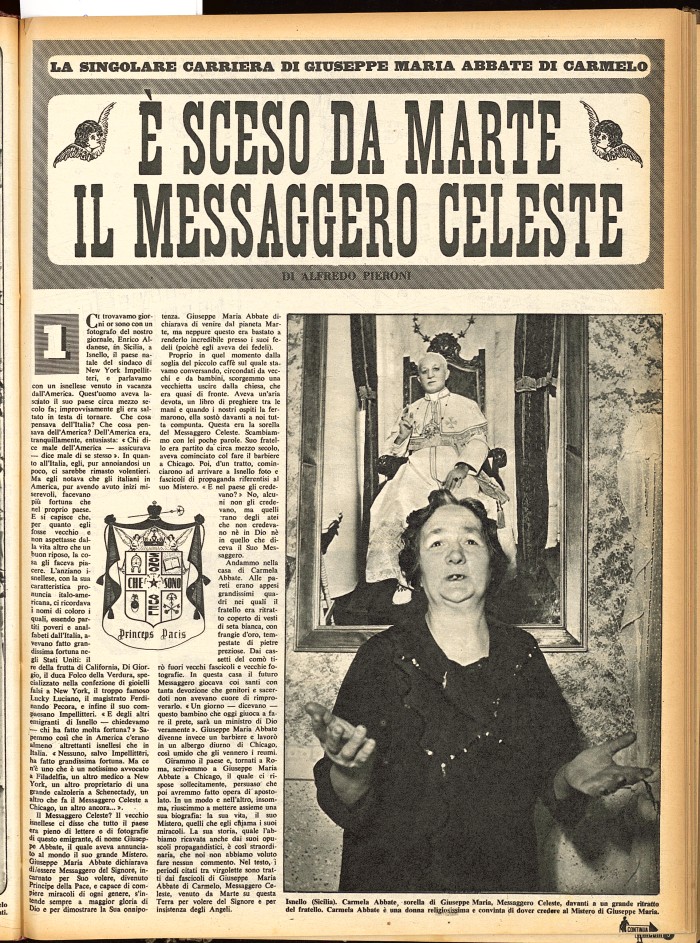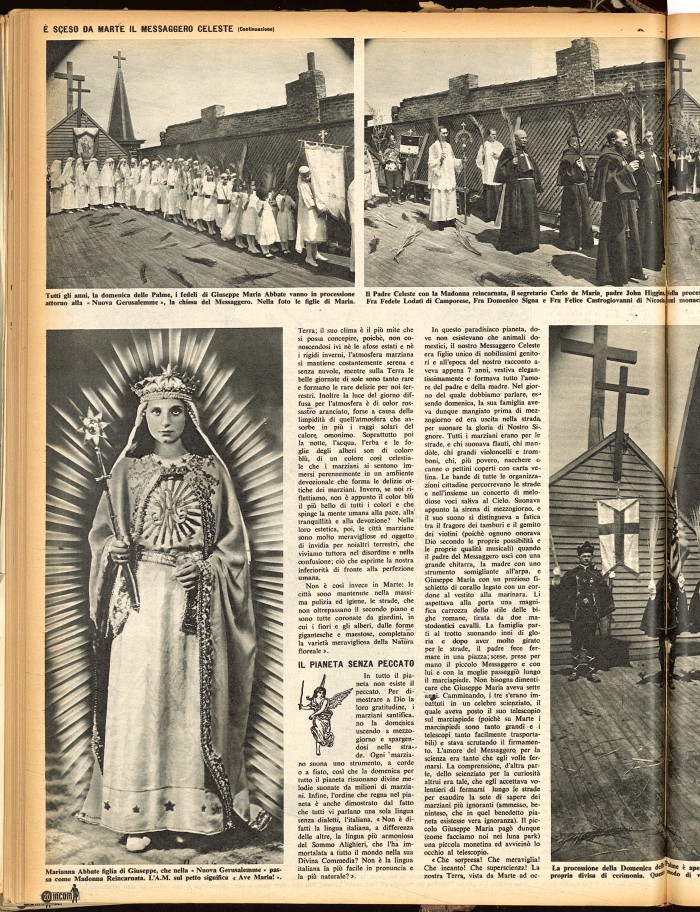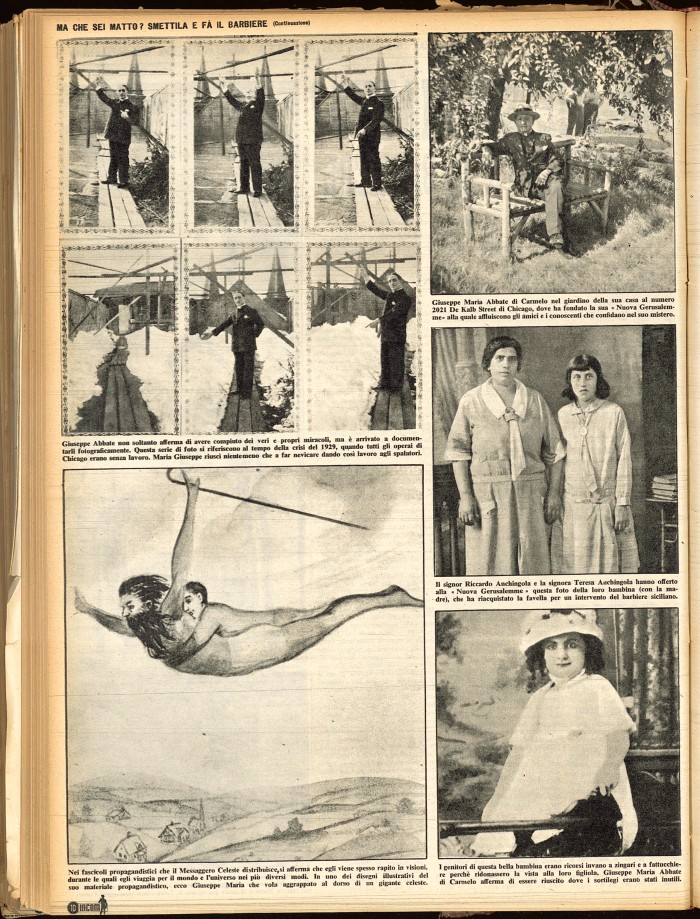I am currently working on a project about Giuseppe Maria Abbate (1886-1963). Born in Sicily, he spent most of his life in Chicago. Abbate claimed that he was a Celestial Messenger and even God incarnate, the Padre Celeste. In 1917, he founded the New Jerusalem Catholic Church of the Celestial Messenger, which attracted at least hundreds of Italian-Americans in the city.
I hope to be able to finish this research report soon, but for now, I post scanned versions of two articles, written by Alfredo Pieroni that were published in the Italian journal La Settimana INCOM illustrata in 1950. The story and the photos are quite astonishing.
EDIT: The book is now published and can be downloaded here












This story reminds me of a Polish-American alternative pope by the name of Adam II. I don’t know, whether you are aware of him. His real name was Adam Antoni Oraczewski (7.10.1883 – August of 1973). He was a Roman Catholic priest, who was once active building St. Joseph’s Church (then dedicated to Our Lady of the Gate of Dawn) in Claremont, NH in September of 1921, in capacity of the parson, of what I understand. Next year he was replaced by another administrator. In the late 1920s he was touring Poland as a preacher and was reportedly popular. Some sources claim that he has by then allready claimed papacy, but the administrative periodical “Ziemia Zamojska” describes his prelection in Zamość in 1927 merely as suggestive, concentrating a bit too much on the author, and his views as “chaotic but interesting”. In the same year he moved to the United States. A Silesian newspaper “Katolik Codzienny” (N.234/1927(30), 13.10.1927) relates his activities there so:
“Rev. Oraczewski promoted to „a pope“.
Having assumed the name of Adam II he sets up a new Church in America. Counting for dupes and dollars.
Well known throughout Poland for his prelections, as well as from his latest political volte, rev. Adam Antoni Oraczewski has currently surfaced in America, where he attempts to establish a new Church, and to himself become – a Polish pope. We learn about these intentions of his from Polish-American press. We can read in “Pittsburczanin” (“The Pittsburgher”), among others, that:
The pope Oraczewski, or – as he styles himself – “pope Adam II” sets up a new Church, which he names “the Holy Catholic Church”. In general, he affirms most of the Roman Catholic dogma, he abolishes only priestly celibacy and male monastic orders, and of nuns he makes deaconesses, among whom any of the medical nurses may also be admitted, as long as they have been blessed by him.
The hierarchy in this new Church forms itself in an automatic manner. All priests, right after their ordination become bishops and are to wear purple cassocks and birettas. After 10 years they become archbishops and put on red sashes over their cassocks, as well as red zucchettos.
After 20 hears of clerical service, archbishops change their cassocks for red ones and title themselves cardinals, and after 10 years of cardinalship, they change their cassocks for white ones with red sashes and become apostles. The “Pope” in turn, having been elected by the apostles, wears white dress, even the slippers – and in such an attire had himself photographed “the pope Oraczewski” on the cover of his booklet, which he has sent to every Polish periodical, hoping to get them to proselytize for his new Church.
As “Jedność Polonia” rightfully remarks, all this looks like a farce, veiling the greed of dollars. “To wit, Pope Adam II proposes to collect a hundred million dollars, and for this money he wishes to buy about 50.000 acres of land in the neighbourhood of Washington, to found there an independent papal state, with an access to the see, and to build under U.S. protectorate …a Vatican” – St. Peter’s basilic for 25 million dollars and a papal palace for 30 million dollars – in short, he wants to recreate in America all the same things that are in Rome, and – well – to rule there undisturbed to the end of his days, which – given that he is now 44 – could amount to quite a long rule.
However the American press don’t expect him to scrub even a million dollars. Yet perhaps he can find some dupes who will give him a few hundred, maybe even a few thousand dollars, so it will pay off to don white cassock and white slippers.”
Other sources supplement the above with the information gleaned from Adam II’s booklet “Wszyscy w jednej wierze” (“All in one faith”) – Oraczewski was ordained on April 8 1919. As a self-proclaimed pope, he stated, that his purpose in life is to find a base, a common ground on which – by way of mutual concessions – all religions, confessions and beliefs could be united into single and rational faith, warranting that none of those religious groups should dominate over another, or oppress another. (One should bear in mind the decidedly modernist leanings of Franciszek Hodur’s Polish National Catholic Church, as well as some other Polish national-catholic groups both in Poland and in America. There were some Polish religious leaders whose universalism went even further – for example rev. Andrzej Huszno posited the unity of all religions and denied the historicity of the Bible as a whole. Huszno, based in Silesia, was for some time associated with Polish-American bishop Francis Mazur of Carmel Henry Carfora succession.) As pope Adam II, Oraczewski offered admission to bishopric not only to Catholic priests, but also to Protestant pastors and Jewish rabbis.
That’s all about Adam II I could find at this time.
LikeLiked by 1 person
No, I didn’t know anything about Adam II. Thank you so very much for making it known to me (and other readers).
LikeLike
The difficulty in tracking rev. Adam A. Oraczewski lays in the fact that he shares the last name with a more significant personage, rev. Czesław Oraczewski, with whom he seems to be confused. Czesław Oraczewski (1891–1965, ordained on 15.7.1914) was a well-known ideologue and activist, famous chiefly for his sovereignist and nationalist activity among Polish population during the Great War, when he promoted the cause of Józef Piłsudski, then by his cooperation with nationalist opposition towards the cabinet of Jędrzej Moraczewski, which paved for him the trajectory towards more and more extreme right, starting with Polish Confederation (where he cooperated with Polish mesianists, among them with a known leader of Polish Martinists, Mieczysław Geniusz), through participation in anti-semitic Judeologist Conferences, culminating in being among the leaders of Pogotowie Patriotów Polskich (Polish Patriot Emergency) a fascist secret society aiming to seize power from the democratic government (with some of the ministers of which the leaders of PPP were acquainted). Shortly before the leaders of PPP started being arrested, Czesław Oraczewski left the country for a while, later to return and testify. After the seize of power by Piłsudski and his loyal socialists in the aftermath of the May Coup in 1926, Oraczewski switched allegiances and became their supporter. This was also when he publicly abandoned priesthood, only to repent later the same year. Canonical penalties on him weren’t lifted until 1936. He spent the war in Warsaw where he participated in meetings of intellectuals in the appartament of Stefan Ossowiecki, a famous Polish psychic, where broad array of parapsychological terms were discussed. In 1946 he became an advocate of cooperation between Poles and the Red Army and USSR. He criticized the stance of Polish episcopate in their conflict with the communist government, and for that he was penalized in 1957 by being banned from preaching and restricted in performing priestly rites to the chappel of a Orionist convent. Throughout interbellum he was giving prelections (some of them patriotic or religious, others decidedly for-profit, often of the “self-help” variety) in Poland and abroad and he seems to have been popular, at least until the mid-1920s.
As it can clearly be seen from this, some of the remarks about pope Adam II in the artcle quoted above and in other sources – such as the allusions to prelections and to a “political volte” seem to pertain rather to Czesław Oraczewski. At this point I’m not certain, whether Adam Oraczewski ever left for Poland after 1921. Only the original articles from Polish-American periodicals or – better still – his own booklet could provide a fuller picture of him.
LikeLike
Thank you for your update. Yes, it’s certainly not easy to study people like Oraczewski or Abbate. Please let me/us know if you find more stuff. I had a look at your website and with the kind help of Google Translate. Good work!
LikeLike
Thanks. It might be just the motivation I needed to finish another post, which has been almost ready for months.
I admire your work, btw.
LikeLike